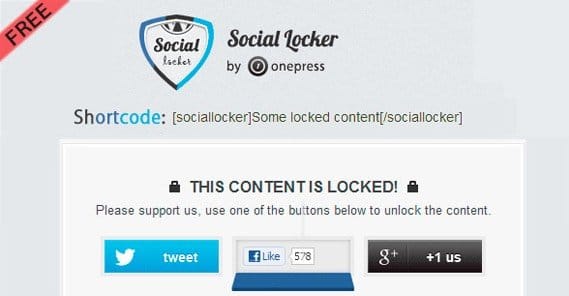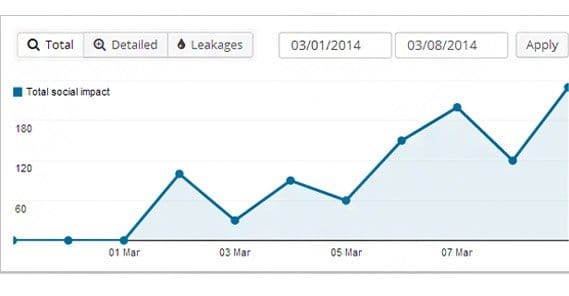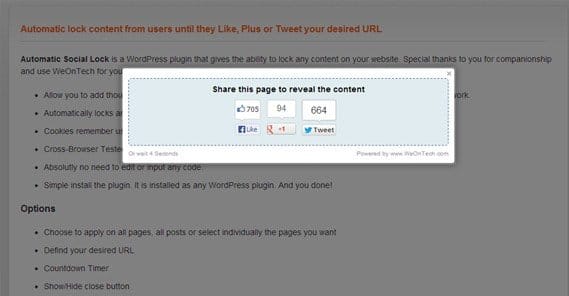Are Social Media Content Lockers Safe for SEO?

Social content lockers are a type of plugin that isn’t used often, and it seems rarely used to good effect. That alone tells me that they aren’t very good for SEO, but I’m always open to new evidence. So, let’s take a look at them and see the way the world lays.
What is a Social Content Locker?
A while back, you would often see contests and occasionally apps on Facebook locked behind a like. If you didn’t like the page, you wouldn’t be able to see the content, use the app, or enter the contest. This was a Like Gate, and it’s a form of social content locker. Today, Like Gates are banned on Facebook, and the functionality was removed from their API.
A social content locker is a similar script for your blog. Essentially, you put the script on your page, and it hovers over blog posts, lurking and waiting. When a user clicks to visit your site from another location – like from Facebook or Twitter – the script triggers. That user is shown the title of the post, and maybe the first line or two, before it fades out.
What replaces it is a box, like many of the exit intent scripts that riddle SEO websites today. Instead of asking you to sign up for a mailing list or consider buying a product, though, this asks for you to tweet about the content, like the site on Facebook, +1 them on Google+, or something else. It’s always a form of social engagement.
The other difference between this sort of script and an exit intent script is that you can close an exit intent script. The social locker requires the user to perform one of those actions, or else they will not be able to view the content.
Some social content lockers, like the one actually named Social Content Locker, offer a time-based incentive as well. It might set itself at 60 seconds. If the user doesn’t want to take social action, but really wants to read the content, they have the option of just waiting for a minute, and the lock will disappear.
What Do Social Content Lockers Do?
Taking a look at this case study, using a social content locker increased social sharing to a significant degree, almost 1000% on Twitter. At the same time, traffic did not increase, nor did it decrease significantly due to the presence of the content locker. When the site owner set the time-based option as well, bounce rate dropped.
Here’s why I’m skeptical of these results.
- They don’t show long-term effects. A user might socially share one post, but if they’re asked to socially share every time they visit, they might start looking for another place for their information.
- They don’t show data after the time-based incentive was added. My guess is that when the option to wait exists, the incentive to share socially disappears. Personally, I often open numerous tabs and it’s often several minutes before I get to them, so I might not even see the social locker before it disappears.
- The numbers are all small scale. A 1000% increase in Twitter tweets is really only a small handful. Specifically, he increased by 10 Facebook shares, 26 tweets, and… 34 Tinyurl referrals? Why is that data even included?
- The post is immediately followed with a referral link to buy the paid version of a social content locker software. It’s rule number one for affiliate sales; make the product look good. No one would click through and buy if it was a negative review.
Onwards, then, to more data.
Looking at SEO Effects
When you boil things down, a social content locker has a few effects. It hides content from a user upon immediate visit. It promotes social shares and, occasionally, longer waits. That’s really it.
Let’s look at the bounce rate thing first. By encouraging users to wait for 60 seconds before they leave, obviously it’s going to decrease bounce rate. The problem is, all it does is hides your real bounce rate. How many of those users leave on the 64th second, having waited for a full minute only to discover your content isn’t what they wanted after all? My guess is that the figure would be about the same. You may make your bounce rate statistics look better, but it doesn’t actually help you.
What about promoting social shares? Yes, a social content locker will get you more social shares… right away. I have a few questions, though.
- What is the effect of those shares? How viral will they be? Normally, the value behind a social share is reaching a wider audience, which in turn can share, which in turn reaches an even larger audience. The ideal situation is a sort of resonance cascade; it explodes, and your content goes viral. You get more shares out of it than were initially put in.
- How many people will continue to share your page socially after they’ve done it before? If the cookie set by the site expires too quickly, those people will be asked to share far more often than they are comfortable doing. They don’t want to clutter their feeds, and they don’t want to keep “paying” to view your content if it’s not supremely good.
My suspicion for the first question is that the shares are not as useful. Even if some of the people who would see your content are willing to share to see it, a smaller percentage of the people who see the shared post will in turn share it again. Most of them – myself included – will just leave out of disgust.
As for the second question, I suspect a social content locker will quickly outgrow its welcome. This is why Like Gates were banned, and it’s why many of the sites that I see talking about how well content lockers worked for them don’t currently run content lockers.
Google and Content Lockers
There are essentially two ways a content locker can work when Google is involved.
- Google does not parse the content locker, and thus is able to read your content without issues.
- Google does parse the content locker, and is thus locked out of the content the same way users would be.
Both of these options are potentially bad for SEO in their own ways. Let’s start with option two.
In option two, Google parses and executes the script that locks your content from being viewed without social engagement or time. Google is not going to wait for a full minute, it would dramatically decrease the efficiency of their crawlers. They are also not going to share your posts on social media; the Googlebot doesn’t have accounts to use. Therefore, your content remains locked to Google. It is not indexed, and thus cannot appear in search.
This could be why I don’t see much in the way of socially locked content these days. If it doesn’t appear in search, how would it be found? That’s just anecdotal, though, so don’t bet on it being true.
In the old days, back in 2010 before the Panda and Penguin updates, Google did not parse or execute Javascript, which is the language most used for social content lockers. This made them safer to use; Google would still see your content, but users would be socially locked.
This brings us to scenario one. Google either does not parse or does not execute the code, and thus is perfectly capable of seeing your content. They index it as normal, and it appears in search. Users, though, are still locked.
These days, Google does parse JavaScript, but they don’t always execute it. This prevents Google from showing up in Google Analytics, among other things. It also helps them prevent being redirected while users are not.
Google hates it when you show one bit of content to the user and another to the search engine. It’s misdirection, and it’s considered a black hat technique. However, a social content locker isn’t strictly a misdirection technique. It delays the user’s ability to view the content, but if they choose to, the content they see is the same as what Google sees.
In this case, the assumption is that a social content locker would not hurt your search ranking organically. It might hurt your reputation, your usability, and your social presence, but it won’t directly hurt your ranking.
There’s one other note to make before we move on. Social content lockers are not 100% effective. They execute using Javascript, which is blocked by popular browser extensions like NoScript. Some browsers even have the option available to turn off scripts, as a security feature. This means users that do not execute Javascript will not see the content locker, and will never know it’s there.
In general, a social content locker may get you an immediate boost in social shares, because users tolerate it for a short time under the assumption that it’s an experiment or it’s temporary, a one-time action to take to unlock all of your content forever. When it appears again, and again, and again, it won’t work any more.
Advice Using Content Lockers
Avoid non-social content lockers. There are three types of content locker, though they all do the same thing. They lock content until a particular action is taken. These are the three general categories:
- Social locker. These hide content until a social media action is taken, like a like or a share.
- Paywalls. These hide content until a membership is purchased or, occasionally, a fee is paid.
- Ad lockers. These are “offers” you have to complete. You can also see these as ways to earn gift cards or game cash in various free to play games. They hide content until the user fills out an offer, typically for an affiliate that pays per qualified lead.
Never use ad lockers. They have an incredibly low success rate, which frustrates the user. They would have to fill out more than one, and they feel scammed out of their content after the first one fails to verify. Worse, it can lead to spam, and they’ll associate that spam with you.
Paywall lockers are a bit more benign, but you really need to have the content to support it. Premium memberships are growing increasingly rare, and these days they’re mostly used for sites that sell products as well. Buy the product, get access to the product-related blog and knowledge base. These are also worse than social lockers, because they block Google as well. Otherwise, users could just view a cached version of your content for free.
Put the code at the bottom of the page, so it doesn’t slow down your page load times. There are two possible problems with putting the code for a social locker at the top of your page. The first problem is, of course, that pages execute from the top down. The web browser has to load and parse the code before it can move on to the next step. Even if this takes a half a second, that’s still half a second that the page spend loading your content locker before it loaded, for example, the content you’re locking. If you have a few other scripts, like social sharing scripts or analytics, it just adds to the loading times.
Loading times are a ranking factor, and a somewhat important one at that. That is, it’s important the longer your load times are. Improving from .24 to .21 seconds isn’t going to give you a noticeable ranking boost, but dropping from 1.3 to 2.3 seconds very much will.
The other problem with putting the code at the top has largely not mattered for the last couple years, but is still a possible issue. If you put a social locker at the top of the page, and it has plaintext in it – like your solicitation to like your page socially – that text is viewed by Google as the top text on the page. This can cause issues with your search description or indexing. It’s rare that those issues come up, but they do exist, and it’s just another reason to make the code execute later.
Make sure the content you lock is very high quality. We’re talking premium content here. If I’m going to share your content socially before I even get to see what it is, I’m going to be mad if it turns out to be valueless. The first thing I’m going to do is go to the social site I used an delete the post or unfollow you. If I’m feeling particularly uncharitable, I might even try to submit a spam report of some kind. Granted, that’s not the typical course of action for most people, but you have to consider what your audience will do if the content they pay for with their social feed is worth viewing.
Never lock essential pages, like your homepage or categories page. If your homepage is socially locked, guess what? I’m not even going to bother. At that point, it’s clear that your emphasis is more on marketing than on value or user experience, and it’s no different than any of the thousand different black hat spam techniques you can use. Only lock download pages, if you must.
You should also, if you’re set on locking normal blog posts, only lock some of them. If your entire blog is locked, you’re telling users that your entire blog is worth paying for, and that somehow it’s only worth their social shares. You’re also setting up a lot of hassle for anyone who wants to read or reference your posts regularly.
One strategy is to identify your most valuable content and put a social lock on it, leaving the rest of your blog open to everyone. Users will eventually get the idea that the best you have to offer is locked, and it’s worth opening.
You could also consider only socially locking your content for a short time. Publish a post, lock it for a week, and after that week is up, remove the locking code. This eliminates any concern of users sharing old and no longer relevant posts. It can also give you a second surge of traffic, if users get to know your schedule and start checking and organically sharing your posts after the first week. I don’t know how well this technique works, of course. I’m just making it up as I go along. Feel free to try it and test it. Let me know how it works!
The Best Way to Use a Social Locker
There’s one great way to use a social locker that is both more common than locking blog posts, and more effective. Even better, it eliminates virtually all of the SEO concerns.
The primary SEO concern about using a social locker is that it can make it more difficult to index the content. What if the content isn’t something that would be indexable in the first place?
What I’m talking about here is premium content, like podcasts and ebooks. This isn’t content Google is indexing, it’s content you’re marketing on the side. Putting a social locker on top of this kind of content is much the same as putting that content behind a landing page that requites the user sign up for your mailing list. It’s just a different sort of payment.
Users are also much more likely to share or follow you on a social network for premium content than they are for blog posts, which are typically viewed as “should be free” regardless.
Overall, this is by far the best way to use a social locker, and it’s perfectly safe for SEO. It’s only when you start locking your blog posts or main pages that it gets iffy, and I would recommend against it.
 ContentPowered.com
ContentPowered.com








hi, Kenny. I was searching for social locker on google and came across your post. It is very detailed and clearly elaborate on the topic. It cleared many of my misconceptions regarding social locker, which I was planning to include on my blog. Thanks for your useful post.
Thank you Kenny. I’ve just bought a social locker plugin and testing its result…
What about locking a link to download particular file… I mean for example, an app for android or iOS devices.